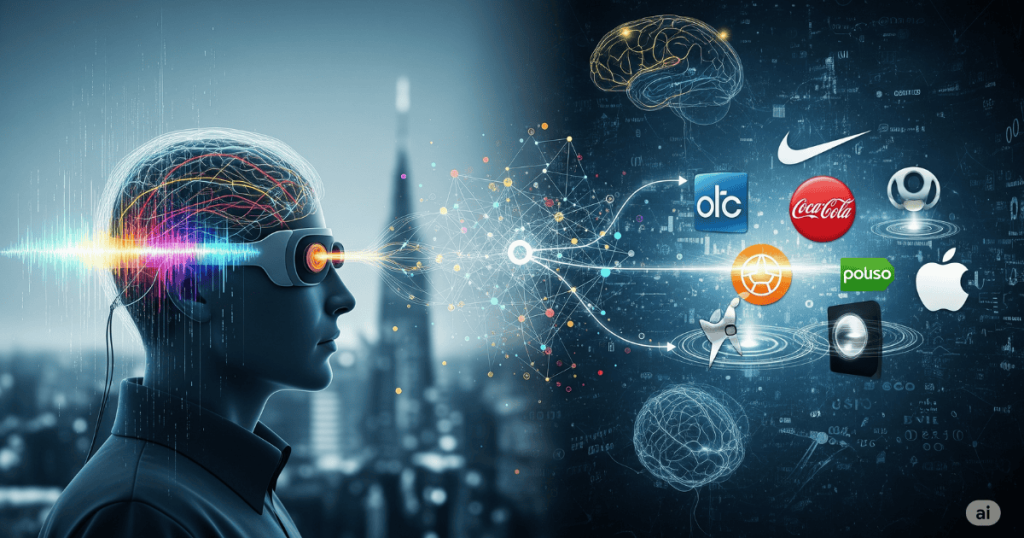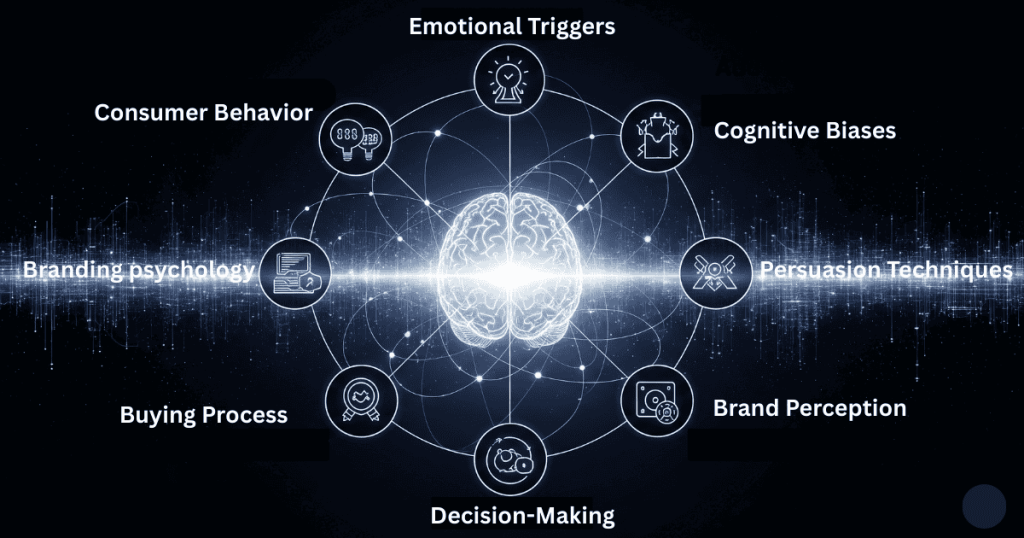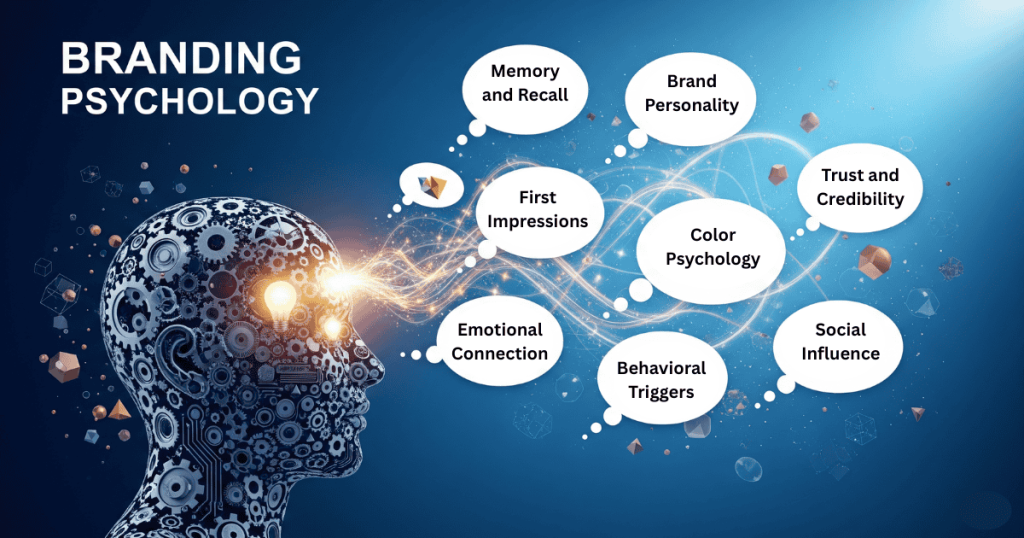Neuromarketing in Branding: Using Psychology to Influence Buyers

Have you ever wondered why you chose one brand over another, even when both products seemed identical? The answer lies hidden in your brain’s neural pathways, where subconscious marketing techniques work their magic long before you consciously make a decision.
Neuromarketing in branding represents a fascinating intersection of brain science and consumer psychology. This field studies how our minds respond to marketing stimuli at a neurological level, revealing insights that traditional market research often misses. While surveys and focus groups tell us what consumers think they want, neuromarketing shows us what actually drives their behavior.
Understanding branding psychology isn’t just academic curiosity—it’s become essential for businesses seeking to influence consumer decisions effectively. Companies like Coca-Cola, Nike, and Apple have invested millions in neuromarketing research, discovering that successful brands don’t just sell products; they trigger specific neural responses that create lasting emotional connections.
This comprehensive guide explores how psychology shapes consumer buying behavior and reveals the neuromarketing strategies that leading brands use to capture hearts, minds, and wallets.
What is Neuromarketing in Branding?
Neuromarketing combines neuroscience, psychology, and marketing to understand how consumers’ brains respond to brand messages. Unlike traditional marketing research that relies on what people say, neuromarketing measures what actually happens in the brain when consumers encounter brands.
The field emerged in the early 2000s when advances in brain imaging technology made it possible to observe neural activity in real-time. Researchers discovered that many purchasing decisions occur in the subconscious mind, often within milliseconds of exposure to a brand stimulus.
Brand perception psychology reveals that our brains process brand information through multiple pathways simultaneously. The rational mind evaluates features and benefits, while the emotional brain responds to colors, shapes, sounds, and associations. Successful neuromarketing strategies align these different processing systems to create coherent, compelling brand experiences.
Modern neuromarketing employs various measurement techniques, including functional magnetic resonance imaging (fMRI), electroencephalography (EEG), and biometric sensors. These tools reveal which brand elements activate reward centers, trigger emotional responses, or create memorable experiences.

The Psychology Behind Consumer Decision-Making
Consumer buying behavior operates through complex psychological mechanisms that often bypass conscious awareness. Behavioral economics in marketing has identified several key principles that shape how we make choices.
The Role of Emotions in Brand Choices
Emotions drive approximately 90% of purchasing decisions, according to brain science research. When consumers encounter brands, their limbic system—the brain’s emotional center—activates before the rational prefrontal cortex can evaluate logical factors like price or features.
Successful brands understand this emotional primacy and craft messages that trigger specific feelings. Apple creates excitement and aspiration, Volvo evokes safety and protection, while Coca-Cola generates happiness and social connection. These emotional triggers in advertising work because they tap into fundamental human needs and desires.
The neuroscience behind emotional branding reveals that positive brand experiences create dopamine releases, reinforcing memory formation and increasing the likelihood of repeat purchases. This explains why customers often remain loyal to brands that make them feel good, even when competitors offer superior products or lower prices.
Cognitive Biases That Shape Brand Perception
Cognitive biases in branding represent systematic errors in thinking that influence how consumers perceive and evaluate brands. These mental shortcuts help us process information quickly, but can be leveraged by savvy marketers.
The availability heuristic makes consumers favor brands they can easily recall. This explains why companies invest heavily in advertising frequency—keeping their brand top-of-mind when purchase decisions arise. Similarly, the anchoring bias causes consumers to rely heavily on the first piece of information they encounter, making initial brand impressions crucial.
Social proof bias drives consumers toward brands that others choose, which is why testimonials, reviews, and celebrity endorsements prove so effective. The scarcity principle creates urgency by suggesting limited availability, while the loss aversion bias makes consumers fear missing out on deals or opportunities.
Understanding these psychological patterns allows brands to structure their messaging in ways that feel natural and persuasive to the human mind.
Core Neuromarketing Strategies for Brands
Effective neuromarketing strategies work by aligning brand messages with how the brain naturally processes information. These techniques influence consumer decisions through multiple sensory and psychological channels.
Visual Elements That Trigger Neural Responses
Visual branding elements can trigger immediate neural responses that shape brand perception within milliseconds. Colors activate different regions of the brain associated with specific emotions and associations. Red stimulates urgency and excitement, blue conveys trust and stability, while green suggests growth and naturalness.
Typography choices also influence neural processing. Rounded fonts appear friendlier and more approachable, while angular fonts seem more professional and authoritative. The spacing, size, and arrangement of text elements guide eye movement and attention, directing consumers toward key messages.
Imagery selection plays a crucial role in brand perception psychology. Faces, especially those showing genuine emotions, activate mirror neurons that create empathetic responses. Products shown in aspirational contexts help consumers envision themselves using the brand, while lifestyle imagery connects products to desired identities.
Storytelling and Emotional Triggers
Human brains are evolutionarily wired to respond to stories. When consumers hear brand narratives, their neural activity synchronizes with the storyteller’s, creating deep engagement and emotional connection.
Effective brand stories follow proven narrative structures that maximize neural engagement. They introduce relatable characters facing challenges, build tension through obstacles, and resolve conflicts in ways that reinforce brand values. This storytelling approach activates multiple brain regions simultaneously, creating rich, memorable experiences.
Marketing persuasion techniques often incorporate archetypal characters that trigger subconscious recognition. The hero’s journey, for instance, positions the consumer as a protagonist overcoming challenges with the brand’s help. This narrative structure appears in countless successful campaigns because it aligns with how our brains naturally process and remember information.
Sensory Branding Techniques
Multi-sensory brand experiences create stronger neural pathways than single-sense encounters. When brands engage multiple senses simultaneously, they increase memory formation and emotional impact.
Audio branding elements like jingles, voice tones, and background music influence mood and recall. The McDonald’s “I’m Lovin’ It” jingle creates instant brand recognition, while luxury brands often use deeper, slower voices to convey premium positioning.
Scent marketing leverages the direct connection between smell and the limbic system. Retail environments use signature scents to create brand associations—think of the distinctive smells in Starbucks coffee shops or Abercrombie & Fitch stores.
Tactile elements influence brand perception through touch. Heavier product packaging suggests higher quality, while specific textures can reinforce brand personalities. Even digital interfaces use haptic feedback to create tactile brand experiences.
Psychological Principles Applied to Brand Building
Understanding fundamental psychological principles enables brands to build stronger connections with consumers by working with, rather than against, natural mental processes.
The Principle of Reciprocity
Reciprocity creates a psychological obligation to return favors, even small ones. Brands leverage this principle by offering free samples, valuable content, or helpful services before asking for purchases. This approach builds goodwill and increases the likelihood of positive responses to sales messages.
Software companies often provide free trials that demonstrate value before requiring payment. Content marketing strategies offer valuable information that helps consumers solve problems, creating reciprocal relationships that support sales efforts.
Social Proof and Herd Mentality
Humans are social creatures who look to others for behavioral guidance, especially in uncertain situations. Social proof leverages this tendency by showing that others have made similar choices.
Customer reviews, testimonials, and user-generated content provide powerful social proof that influences purchasing decisions. Brands that display popularity metrics—number of customers served, items sold, or positive reviews—tap into herd mentality to encourage similar choices.
Celebrity endorsements work through aspirational social proof, suggesting that choosing specific brands will help consumers align with admired figures. Influencer marketing extends this principle by leveraging micro-celebrities who seem more relatable and authentic.
Authority and Credibility Markers
People naturally defer to perceived experts and authorities. Brands build authority through various credibility markers that signal expertise and trustworthiness.
Professional certifications, industry awards, and expert endorsements establish brand authority. Medical brands, for instance, often feature doctor recommendations, while technology companies highlight industry recognition and technical specifications.
Thought leadership content positions brands as knowledgeable authorities in their fields. By sharing insights, research, and expertise, companies build credibility that supports sales efforts and premium positioning.
Measuring the Impact of Neuromarketing
Understanding whether neuromarketing strategies work requires sophisticated measurement approaches that go beyond traditional metrics.
Neurological Measurement Techniques
Advanced neuroscience tools provide direct insights into brain responses to brand stimuli. fMRI scans reveal which brain regions activate during brand exposure, showing emotional engagement, memory formation, and decision-making processes.
EEG monitoring measures electrical brain activity, providing real-time feedback on attention, engagement, and emotional responses. This technology helps optimize advertising elements like pacing, music, and visual composition.
Eye-tracking technology reveals visual attention patterns, showing which brand elements capture and hold consumer focus. Heat maps generated from eye-tracking data guide design decisions for packaging, websites, and advertisements.
Behavioral and Biometric Indicators
Biometric sensors measure physiological responses that indicate emotional engagement and cognitive load. Heart rate variability, skin conductance, and facial muscle activity provide objective measures of consumer reactions.
Purchase behavior data reveals the ultimate impact of neuromarketing efforts. By analyzing buying patterns, conversion rates, and customer lifetime value, brands can assess whether psychological strategies translate into business results.
A/B testing with neurological measurement combines traditional marketing experimentation with brain science insights. This approach reveals not just which versions perform better, but why they succeed from a neurological perspective.
Ethical Considerations in Neuromarketing
The power of neuromarketing raises important ethical questions about consumer manipulation and informed consent. Responsible brands must balance persuasive effectiveness with respect for consumer autonomy.
The Fine Line Between Influence and Manipulation
Ethical neuromarketing focuses on creating genuine value and positive experiences rather than exploiting psychological vulnerabilities. The distinction lies in whether techniques serve mutual benefit or primarily serve brand interests at consumer expense.
Manipulative practices might exploit cognitive biases to encourage harmful behaviors or unnecessary purchases. Ethical approaches use psychological insights to improve user experiences, communicate value more effectively, or help consumers make better-informed decisions.
Building Trust Through Transparency
Trust-based marketing approaches acknowledge the use of psychological principles while maintaining respect for consumer intelligence. Brands can be persuasive without being deceptive by focusing on authentic benefits and honest communication.
Transparency about data collection and usage builds trust while enabling personalized experiences. Consumers increasingly accept psychological targeting when they understand and benefit from the enhanced relevance it provides.
Dig Deeper: The Neuroscience of Brand Loyalty: What Creates Emotional Connections
The Future of Psychology in Marketing
Emerging technologies and growing psychological understanding continue expanding neuromarketing possibilities while raising new challenges and opportunities.
Artificial Intelligence and Personalization
AI systems can analyze vast amounts of consumer data to identify individual psychological patterns and preferences. Machine learning algorithms optimize brand messages for specific personality types, emotional states, and behavioral tendencies.
Predictive analytics powered by psychological insights enables brands to anticipate consumer needs and deliver relevant messages at optimal moments. This capability transforms marketing from reactive communication to proactive value delivery.
Virtual and Augmented Reality Experiences
Immersive technologies create unprecedented opportunities for psychological engagement. Virtual reality experiences can trigger powerful emotional responses and create memorable brand associations that traditional media cannot match.
Augmented reality applications blend digital brand experiences with physical environments, creating new possibilities for sensory marketing and contextual relevance.
Building Your Neuromarketing Strategy
Implementing effective neuromarketing requires systematic approaches that integrate psychological insights with business objectives and brand values.
Start by understanding your target audience’s psychological profiles, including their values, fears, desires, and decision-making patterns. Consumer research should explore not just what customers want, but why they want it and how they process brand information.
Audit your current brand elements through a psychological lens. Evaluate colors, typography, imagery, messaging, and sensory elements for their neurological impact. Identify opportunities to strengthen emotional connections and reduce cognitive friction.
Test psychological approaches systematically, measuring both neurological responses and business outcomes. Use A/B testing, focus groups with biometric monitoring, and purchase behavior analysis to validate strategy effectiveness.
Integrate neuromarketing insights across all brand touchpoints, from advertising and packaging to retail environments and digital experiences. Consistency amplifies psychological impact and strengthens brand recognition.
Transforming Brands Through Brain Science
Neuromarketing in branding represents more than just another marketing tactic—it’s a fundamental shift toward understanding and respecting how human minds actually work. By aligning brand strategies with psychological realities, companies can create more effective, ethical, and mutually beneficial relationships with consumers.
The most successful brands of the future will be those that master the delicate balance between psychological influence and authentic value creation. They’ll use brain science not to manipulate, but to communicate more clearly, connect more deeply, and serve customer needs more effectively.
As our understanding of consumer psychology continues evolving, brands that invest in neuromarketing capabilities today will be best positioned to thrive tomorrow. The question isn’t whether psychology will influence your brand—it already does. The question is whether you’ll harness these insights intentionally to create better experiences for everyone involved.








